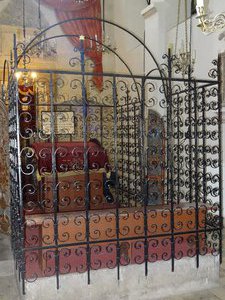Advertisement
Published: August 15th 2013

 Krakow
Krakow
Inside the Jewish Synagogue.Our time in Krakow is limited so we decided to hire the services of a guide to take us through the Old Jewish District today. Prior to World War II there were 70,000 Jews living in Krakow. Only 5,000 survived the war and few of those returned to Krakow. As a result the Jewish Community were forced to sell off the majority of the 13 synagogues in Krakow as they had neither the money nor the community to support their existence. Our guide took us to one of the few remaining functioning synagogues in Krakow. Clive had to wear a yamaka in the temple which, to my great regret, I was not quick enough to photograph. Covered his bald spot perfectly! The synagogue, like many of the old buildings in Krakow, is being renovated and restored but it is a long slow process and relies on donations to pay for the work to be done.
We were also shown the location of a ritual Jewish bathhouse (Mikvah) that was in use up until WWII and is now a kosher restaurant. Ironically it imports the kosher food from the United Kingdom as the Jewish population in Krakow is now so small

 Krakow
Krakow
Remains of ghetto wall in Krakow.(approximately 200) that there is not the demand to produce it themselves. For the most part the restaurant caters for Jewish tourists on pilgrimage to Krakow.
During World War II the Nazis created a ghetto within the Jewish District. The arch design of the wall surrounding the ghetto symbolises a tombstone. The Nazis wanted a constant reminder for the Jews living in the ghetto of what was waiting for them. Only two small sections of the wall still exist.
The main square within the Jewish District, which was once a bustling market place and the location of a train station, is now a memorial. It is the place where the Jews of Krakow were gathered before being sent to Auschwitz. Scattered through the square are oversized chairs facing away from Krakow. They symbolise the furniture, possessions and homes that the Jews were forced to leave behind.
Our last stop on the tour was to Oskar Schindler's enamel factory which is now a museum. It tells the story of Schindler in detail but also displays a permanent exhibition called 'Krakow under Nazi Occupation 1935 - 1945'. The film footage and photographs on display are impressive.
Everywhere throughout

 Krakow
Krakow
Memorial in what used to be the market square in the Jewish District.the Jewish District are reminders of the lives of the Krakow Jewish Community before, during and after World War II. The Polish people are working hard to preserve what they can of this part of their history and they are incredibly respectful in the way that they present it to tourists.
We don't want everyone to think that our stay here in Krakow has all been heavy going because it really hasn't been! We've done lots of other sightseeing here. It's all amazing and so different to what we know back home. We are trying, as much as possible, to eat the local dishes and drink the local wine and beer. So it's been lots of pork, cabbage, fish and potatoes. The Poles certainly love their potatoes! The food is cheap and the servings are massive! Somehow though we are cleaning up our plates. Must be all that walking! Wine is very hit and miss. Probably more miss than hit. Clive is doing his very best to sample every polish beer that exists. Oh and the Poles make great coffee which is a relief after the excuse for a cup of coffee we were served in Paris.
Advertisement
Tot: 0.046s; Tpl: 0.01s; cc: 7; qc: 24; dbt: 0.0289s; 1; m:domysql w:travelblog (10.17.0.13); sld: 1;
; mem: 1mb

 Krakow
Krakow
 Krakow
Krakow
 Krakow
Krakow




